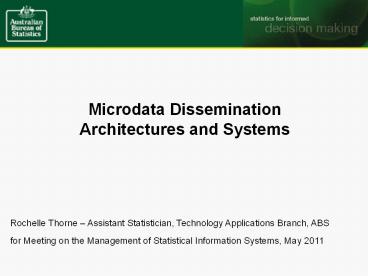Microdata Dissemination - PowerPoint PPT Presentation
Title:
Microdata Dissemination
Description:
Microdata Dissemination Architectures and Systems Rochelle Thorne Assistant Statistician, Technology Applications Branch, ABS for Meeting on the Management of ... – PowerPoint PPT presentation
Number of Views:65
Avg rating:3.0/5.0
Title: Microdata Dissemination
1
- Microdata Dissemination
- Architectures and Systems
Rochelle Thorne Assistant Statistician,
Technology Applications Branch, ABS for Meeting
on the Management of Statistical Information
Systems, May 2011
2
Presentation Outline
- Microdata Dissemination the business problem
- Drivers and Strategy
- ABS systems and architecture
- Learnings and Challenges
3
1. Microdata Dissemination The Business Problem
The Business Problem
- User demand for access to microdata is increasing
at a rapid rate - Timely, automated access to data, including rich
metadata - Issues
- Legislation
- Privacy and confidentiality
- Security
- Legacy systems
- Lack of internal standards
- Technology choices
- Strategic partnerships with vendors
- Performance
4
1. Microdata Dissemination The Business Problem
Brief History of Microdata Dissemination in the
ABS
- Releasing Confidentialised Unit Record Files
(CURFs) since 1985 - Remote Access Data Library (RADL) in 2003
- ABS Data Laboratory (ABSDL) in 2003
- TableBuilder in use since 2009
- Micro (administrative tool) now in production
- Remote Execution Environment for Microdata (REEM)
to be released in July 2011
5
The Journey
2. Drivers and Strategy
6
2. Drivers and Strategy
User Demand
- Access to
- A wider range of microdata
- More detailed unit record data
- Linked and longitudinal datasets
- Rich metadata
- Real-time access to outputs
- More flexible analytical tools
- Automation (system to system interfaces)
7
2. Drivers and Strategy
Information Management Transformation program
(IMTP)
- Major organisational change program outcomes
include - Increased quality/reliability of ABS products and
services - Increased granularity of data
- Increased discoverability of ABS data /
information - Increased access to ABS products / data
- Decreased time to market of statistical products
/ data - Increased coherence of ABS / other data sources
- Increased levels of service to developing
countries within the region - International collaboration to develop a
statistical industry
8
2. Drivers and Strategy
Information Management Transformation program
(IMTP)
- Major organisational change program outputs
include - Metadata infrastructure based on DDI and SDMX
- Business Process Management System (BPMS)
- Registries and repositories for data and metadata
artefacts - Collaboration with other NSOs to produce common
statistical infrastructure
9
2. Drivers and Strategy
GSIM and GSBPM
- Generic Statistics Information Model (GSIM)
- Generic Statistical Business Process Model
(GSBPM) - Key standards to industrialise the production
of statistics - GSBPM the reference model for statistical
business processes - GSIM information flows between the BSBPM
components - Common terminology and definitions
10
2. Drivers and Strategy
Services Oriented Architecture (SOA)
- Reuse of well designed components
- Loose coupling of systems, both internally and
externally - Agility to meet client demands - extensible
- Plug in or pull out components
11
3. ABS Systems and Architecture
RADL
- Remote job submission
- SAS, SPSS and STATA
- Clients are academics and policy researchers
- Multi-tier, multi-server application with a
Notes/Domino front-end and a Windows application
server backend - Allows client access to more detailed data than
CURFs on CD-ROM - ABS can intervene where privacy or
confidentiality issues are identified - - Limited analytical functionality allowed
- - Limited access to metadata
- - Turnaround times can be slow
12
3. ABS Systems and Architecture
ABSDL
- On-site facility
- Remote desktop over a segregated VLAN
- clients have access to richer CURFs
- realtime access to analysis outputs
- ABS can intervene where privacy or
confidentiality issues are identified - - rarely used due to accessibility and cost
13
3. ABS Systems and Architecture
REEM
- Remote, real-time analysis
- Access to richer datasets
- Confidentiality processes performed on outputs
- Complex analysis services
- Metadata discovery
- Linked and longitudinal datasets
- geospatial mapping
14
4. Learnings and Challenges
Learnings and Challenges
- Legacy systems and business processes
- Metadata Content
- Standards
- Confidentiality and Privacy
- Integration
- International Collaboration
15
4. Learnings and Challenges
What are other organisations doing?
- Focus on DDI and SDMX
- Documentation of principles and guidelines
- Looking to share statistical infrastructure
16
Thank you































